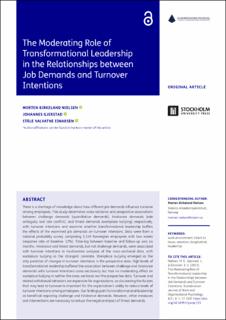| dc.contributor.author | Nielsen, Morten Birkeland | |
| dc.contributor.author | Gjerstad, Johannes | |
| dc.contributor.author | Einarsen, Ståle Valvatne | |
| dc.date.accessioned | 2024-02-13T07:50:21Z | |
| dc.date.available | 2024-02-13T07:50:21Z | |
| dc.date.created | 2023-09-07T10:48:01Z | |
| dc.date.issued | 2023 | |
| dc.identifier.citation | Scandinavian Journal of Work and Organizational Psychology. 2023, 8 (1), . | en_US |
| dc.identifier.issn | 2002-2867 | |
| dc.identifier.uri | https://hdl.handle.net/11250/3117113 | |
| dc.description.abstract | There is a shortage of knowledge about how different job demands influence turnover among employees. This study determines cross-sectional and prospective associations between challenge demands (quantitative demands), hindrance demands (role ambiguity and role conflict), and threat demands (workplace bullying), respectively, with turnover intentions and examine whether transformational leadership buffers the effects of the examined job demands on turnover intentions. Data were from a national probability survey comprising 1,149 Norwegian employees with two waves (response rate at baseline: 32%). Time-lag between baseline and follow-up was six months. Hindrance and threat demands, but not challenge demands, were associated with turnover intentions in multivariate analyses of the cross-sectional data, with workplace bullying as the strongest correlate. Workplace bullying emerged as the only predictor of changes in turnover intentions in the prospective data. High levels of transformational leadership buffered the association between challenge and hindrance demands with turnover intentions cross-sectionally but had no moderating effect on workplace bullying in neither the cross-sectional nor the prospective data. Turnover and related withdrawal behaviors are expensive for organizations, so discovering the factors that may lead to turnover is important for the organization’s ability to reduce levels of turnover intentions among employees. Our findings point to transformational leadership as beneficial regarding challenge and hindrance demands. However, other measures and interventions are necessary to reduce the negative impact of threat demands. | en_US |
| dc.language.iso | eng | en_US |
| dc.rights | Navngivelse 4.0 Internasjonal | * |
| dc.rights.uri | http://creativecommons.org/licenses/by/4.0/deed.no | * |
| dc.title | The Moderating Role of Transformational Leadership in the Relationships between Job Demands and Turnover Intentions | en_US |
| dc.type | Peer reviewed | en_US |
| dc.type | Journal article | en_US |
| dc.description.version | publishedVersion | en_US |
| cristin.ispublished | true | |
| cristin.fulltext | original | |
| cristin.qualitycode | 1 | |
| dc.identifier.doi | 10.16993/sjwop.193 | |
| dc.identifier.cristin | 2173145 | |
| dc.source.journal | Scandinavian Journal of Work and Organizational Psychology | en_US |
| dc.source.volume | 8 | en_US |
| dc.source.issue | 1 | en_US |
| dc.source.pagenumber | 17 | en_US |

